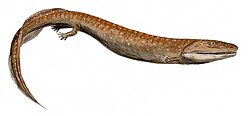| Kyrinion Temporal range: Late Carboniferous | |
|---|---|
| Scientific classification | |
| Domain: | Eukaryota |
| Kingdom: | Animalia |
| Phylum: | Chordata |
| Clade: | Sarcopterygii |
| Clade: | Tetrapodomorpha |
| Family: | † Baphetidae |
| Subfamily: | † Loxommatinae |
| Genus: | † Kyrinion Clack, 2003 |
| Species | |
| |
Kyrinion is an extinct genus of baphetid tetrapodomorph from the Late Carboniferous of England. It is known from a skull that was found in Tyne and Wear county dating back to the Westphalian stage. Along with the skull is part of the lower jaw, an arch of the atlas bone (the vertebra that connects to the skull) and a rib possibly belonging to a cervical (neck) vertebra. The type species K. martilli was named from this material in 2003.





